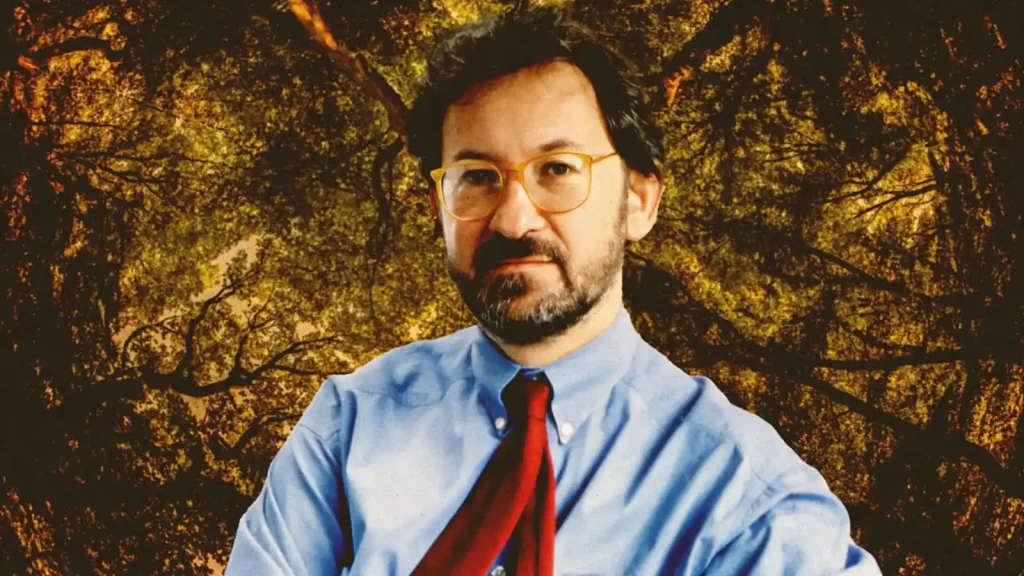In Landscape and Memory episode 4 acclaimed historian Simon Schama takes us on a captivating journey across the seas, diving deep into how these vast expanses have stirred the imagination of artists, writers, and explorers throughout history. The sea—a symbol of mystery, boundless beauty, and formidable power—has left an indelible mark on human culture, inspiring everything from epic tales of exploration to stunning works of art that capture its shifting moods.
Schama invites us to explore the sea’s dual nature—its capacity to nurture dreams and ignite fears. Throughout the centuries, the sea has been both a path to discovery and an untamable force, an idea that has enchanted writers and poets for generations. From Homer’s odyssey to the stormy adventures of seafaring explorers like Christopher Columbus and Ferdinand Magellan, the ocean’s depth has provided a fertile backdrop for stories of ambition, courage, and the unknown.
Painters, too, have embraced the sea as a muse, depicting the sublime beauty and inherent danger of the ocean. The sublime—a concept in art that expresses awe alongside terror—finds its perfect embodiment in the ever-changing waves. Artists like J.M.W. Turner used sweeping brushstrokes to convey the dynamic energy of the sea, capturing not just its physical nature but its emotional resonance. The swirling skies and crashing waves of Turner’s seascapes, infused with the grandeur of Romanticism, evoke the ocean’s power to both inspire and unsettle.
The documentary also delves into maritime art as a genre, exploring how painters across different eras have used the sea as a canvas to reflect human emotions and ambitions. The tumultuous seas were often depicted with violent storms and perilous waves, representing the struggles of existence. But there were also serene renderings of calm coastal landscapes—images of harmony that provided viewers with a sense of peace. These varied representations help illustrate our evolving relationship with the ocean, from fear and fascination to appreciation.
Simon Schama’s exploration doesn’t stop with the brush and pen; he takes us through the stories of the great explorers who navigated these unforgiving waters, guided by stars and the promise of undiscovered worlds. The sea was, for many centuries, the edge of the known universe—an enigmatic blue frontier that only the bravest dared to cross. Figures like Magellan, who circumnavigated the globe, and Captain Cook, who charted unknown territories, transformed our understanding of the world’s boundaries. The mythology of the sea, filled with sea monsters and shipwrecks, painted these explorers as daring adventurers facing challenges beyond comprehension.
These epic tales of seafaring did more than expand our geographical knowledge; they also reshaped the cultural landscape. Writers chronicled daring voyages, turning real and imagined adventures into stories that stirred the souls of their readers. Maritime exploration brought forth tales of danger and wonder, with sailors recounting encounters with uncharted lands, exotic creatures, and mythical monsters lurking beneath the ocean’s surface. It’s no surprise that the sea became an enduring theme in literature—a metaphor for life’s trials and the endless search for meaning. Even today, the ocean represents the unknown, the vast uncharted territory that humans are irresistibly drawn to conquer.
The Romantic era, with its penchant for the sublime and the mysterious, made the sea a central motif in its poetry and prose. Lord Byron’s vivid imagery of the waves, the shifting tides, and the restless sea spoke of both freedom and danger. The ocean became a symbol of uncontainable spirit and the limits of human power. Coleridge’s “The Rime of the Ancient Mariner” is perhaps one of the best-known examples of how the sea’s unpredictable nature can be both a setting for an epic narrative and a character within the story—a force that punishes and redeems.
Landscape and Memory episode 4 – Seas
Cultural history also ties into the stories of navigation and the mythology of the sea. Coastal communities have long lived with the blessings and the perils brought by the ocean. Their myths—tales of sea monsters, lost cities beneath the waves, and spirits that haunt the deep—speak to humanity’s enduring fascination with what lies beneath the surface. Shipwrecks have been tragic, but they have also inspired awe, leaving behind ghostly reminders of nature’s power over human ambition. These wrecks, now sometimes displayed in museums, tell stories of adventure and loss, bringing the past into the present.
Maritime museums and art exhibitions today continue to celebrate this relationship between humans and the sea. Displays of marine art, from intricate models of ships to Turner’s stormy masterpieces, help us appreciate the role of the sea in shaping cultural identity. Such exhibitions allow viewers to experience the sea as a muse—a constant source of inspiration, fear, and reflection. Schama’s exploration highlights how this deep connection between humanity and the ocean has not waned over time. If anything, it has only grown stronger as we continue to be enchanted by the mysteries of the deep.
The narrative of “Landscape and Memory” also touches on modern understandings of the sea. Today, the ocean remains a symbol of both possibility and fragility—a place of beauty that we must strive to protect. The waves that once carried explorers to new worlds now serve as a stark reminder of our environmental responsibilities. Rising sea levels and the threat to marine ecosystems underline the delicate balance between humanity and nature, a theme Schama subtly brings into his discussion, reminding us that the sea’s legacy is both a gift and a responsibility.
Simon Schama’s storytelling in this episode reveals the sea as more than just a body of water—it’s a mirror of human experience. From the courageous explorers who mapped new horizons to the artists who captured its beauty and terror, the ocean has shaped our world in profound ways. “Landscape and Memory” brings these stories to life, painting a vivid picture of how the seas have left their mark on art, culture, and our collective imagination. In every crashing wave and every horizon line, there lies a story of discovery, fear, hope, and the eternal human desire to explore.
Conclusion Landscape and Memory episode 4 – Seas
As we conclude this journey through the “Landscape and Memory” episode on the seas, we are left with a profound appreciation for the ocean’s unyielding grip on human imagination. The sea—at once beautiful and fearsome—has always been more than just a geographical feature. It is a powerful metaphor for life’s uncertainties, the embodiment of adventure, and a reminder of our innate drive to push past boundaries. The ocean challenges us, both physically and spiritually, inviting us to face the unknown with courage and curiosity.
From the earliest navigators who gazed at the horizon, wondering what lay beyond, to the artists and writers who captured its restless beauty, the sea has inspired countless tales of discovery and transformation. It has been a cradle of civilization, a theater of myths, and a muse for poets and painters alike. Simon Schama’s exploration illuminates these diverse threads, showing us that the ocean is much more than a body of water; it is the origin of countless dreams, triumphs, and myths that continue to shape our culture today.
But the sea’s power is not merely in its ability to inspire—it is also in its reminder of our fragile connection to the natural world. The waves that carried the explorers of the past now also carry warnings about our planet’s future. Rising tides and endangered ecosystems are a call to action, urging us to respect and protect this vast expanse that has given us so much. The sea’s story is still being written, and it is up to us to determine what comes next. Will we heed its lessons of resilience and adaptation, or will we let its beauty slip through our fingers?
In this episode, Schama has guided us to see the sea as a mirror—reflecting both the vastness of our hopes and the depths of our fears. It is a symbol of the sublime, of endless horizons that invite exploration and of waves that carry both peril and promise. As we stand at the shore, watching the tides ebb and flow, we are reminded that our journey, like the sea, is never truly over. There will always be new horizons to seek, new stories to tell, and new depths to explore—a testament to the enduring bond between humanity and the ever-enigmatic ocean.
FAQ Landscape and Memory episode 4 – Seas
Q: What is the central theme of “Landscape and Memory” episode 4?
A: This episode delves into the profound relationship between humanity and the sea, exploring how this vast expanse has inspired artists, writers, and explorers throughout history. Furthermore, it examines the sea as a source of mystery, beauty, and power, and how these aspects have shaped our cultural identity.
Q: How does the episode portray the sea’s influence on art?
A: The episode showcases how painters have used the sea to evoke a range of emotions, from awe and terror to tranquility and peace. For instance, artists like J.M.W. Turner captured the sublime nature of the ocean, conveying its dynamic energy and emotional resonance through their brushstrokes. Moreover, the episode explores maritime art as a genre, highlighting how artists have used seascapes to reflect human ambitions and anxieties.
Q: In what ways does the episode connect the sea to literature?
A: The episode illustrates how the sea has been a rich source of inspiration for writers and poets, serving as a backdrop for stories of adventure, courage, and the unknown. From Homer’s “Odyssey” to Coleridge’s “The Rime of the Ancient Mariner,” the sea has been a powerful metaphor for life’s journeys, challenges, and the search for meaning. Additionally, the episode discusses how maritime exploration fueled the creation of captivating tales that broadened our understanding of the world.
Q: Why does the episode focus on explorers like Magellan and Captain Cook?
A: The episode highlights explorers like Magellan and Cook because they represent humanity’s drive to explore and conquer the unknown. Their voyages, once considered journeys to the edge of the world, expanded geographical knowledge and fueled cultural imagination. In essence, these explorers embody the spirit of adventure and the human desire to push boundaries, themes that are central to the episode’s exploration of the sea.
Q: How does “Landscape and Memory” connect the sea to modern environmental concerns?
A: While celebrating the sea’s influence on human culture, the episode also acknowledges its fragility. Specifically, it touches on rising sea levels and threats to marine ecosystems, reminding us of our responsibility to protect this precious resource. Ultimately, the episode suggests that the sea’s legacy is not just a source of inspiration but also a call to action for environmental stewardship.





Would have loved to have watched this series but the video was showing a 15 second ad every 3 minutes exactly. Made the programme completely unwatchable as it takes a minute or two to refocus after each ad and then it’s almost time for the next ad. We gave up on the whole series exactly 12 minutes into episode 1 when the 4th ad break was starting. We will look elsewhere in future.
try different stream on the page